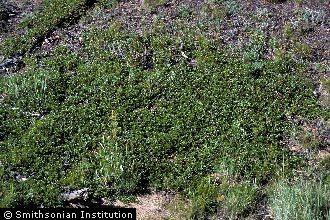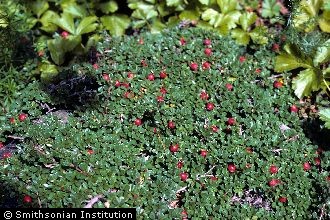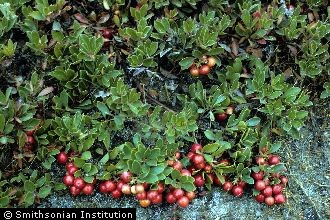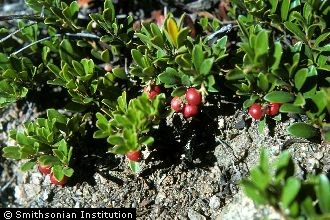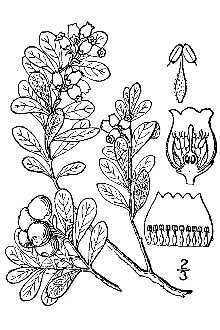Arctostaphylos uva-ursi (L.) Spreng. ssp. monoensis J.B. Roof
Scientific Name: Arctostaphylos uva-ursi (L.) Spreng. ssp. monoensis J.B. Roof
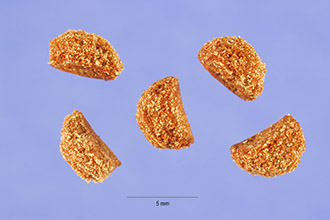
| General Information | |
|---|---|
| Usda Symbol | ARUVM3 |
| Group | Dicot |
| Life Cycle | Perennial |
| Growth Habits | ShrubSubshrub, |
| Native Locations | ARUVM3 |
Plant Guide
Use soil moisture sensors to measure the soil moisture of Arctostaphylos uva-ursi (L.) Spreng. ssp. monoensis J.B. Roof.
Fact Sheet
Alternate Names
kinnikinnick , Use soil moisture sensors to measure the soil moisture of Arctostaphylos uva-ursi (L.) Spreng. ssp. monoensis J.B. Roof.
Uses
Bearberry serves a dual role on sandy soils, as both a beautification plant as well as a critical area stabilizer. The thick, prostrate, vegetative mat and evergreen character are what make bearberry a very popular ground cover. It is often planted around home sites, sand dunes, sandy banks, and commercial sites. The fruit it produces is eaten by a few species of songbirds and game animals. Deer will sometimes browse the foliage lightly.
Status
Please consult the PLANTS Web site and your State Department of Natural Resources for this plant’s current status (e.g. threatened or endangered species, state noxious status, and wetland indicator values).
Description
Pure stands of bearberry can be extremely dense, with heights rarely taller than 6 inches. Erect branching twigs emerge from long flexible prostrate stems, which are produced by single roots. The trailing stems will layer, sending out small roots periodically. The finely textured velvety branches are initially white to pale green, becoming smooth and red-brown with maturity. The small solitary three scaled buds are dark brown. The simple leaves of this broadleaf evergreen are alternately arranged on branches. Each leaf is held by a twisted leaf stalk, vertically. The leathery dark green leaves are an inch long and have rounded tips tapering back to the base. In fall, the leaves begin changing from a dark green to a reddish-green to purple. Charles Webber © California Academy of Sciences @ CalFlora Terminal clusters of small urn-shaped flowers bloom from May to June. The perfect flowers are white to pink, and bear round, fleshy or mealy, bright red to pink fruits called drupes. This smooth, glossy skinned fruit will range from 1/4 to 1/2 inch in diameter. The fruit will persist on the plant into early winter. Each drupe contains 1 to 5 hard seeds, which need to be scarified and stratified prior to germination to reduce the seed coat and break embryo dormancy. There is an average of 40,900 cleaned seeds per pound.
Adaptation and Distribution
Distribution
Distribution
Bearberry’s native range is from Labrador to Alaska, south to Virginia, Illinois, Nebraska, and in the mountains from New Mexico north through California to Alaska. This long-lived, low growing shrub is very cold tolerant. This plant prefers coarse well to excessively drained soils of forests, sand dunes, bald or barren areas. It does not tolerate moist or off-drained sites. Although bearberry is often found growing in the open on sand dunes, it grows well under partial shade of forest canopies. For a current distribution map, please consult the Plant Profile page for this species on the PLANTS Website.
Establishment
Bearberry can be propagated from seeds, softwood cuttings or pre-rooted stem cuttings. It is difficult to root this plant from bare cuttings in the greenhouse. Scarified seed sown in early summer will improve germination the following spring, but this technique is not as reliable as cuttings. Softwood cuttings should be harvested in late summer, and rooted stem cuttings are most successful when harvested during the dormant season. Successfully grown seedlings or cuttings should be handled carefully in containers; bare root plantings are rarely effective.
Plant Traits
Growth Requirements
| Temperature, Minimum (°F) | -33 |
|---|---|
| Adapted to Coarse Textured Soils | Yes |
| Adapted to Fine Textured Soils | No |
| Adapted to Medium Textured Soils | Yes |
| Anaerobic Tolerance | None |
| CaCO3 Tolerance | Medium |
| Cold Stratification Required | Yes |
| Drought Tolerance | High |
| Fertility Requirement | Low |
| Fire Tolerance | Low |
| Frost Free Days, Minimum | 140 |
| Hedge Tolerance | None |
| Moisture Use | Low |
| pH, Maximum | 8.0 |
| pH, Minimum | 5.5 |
| Planting Density per Acre, Maxim | 10912 |
| Planting Density per Acre, Minim | 1746 |
| Precipitation, Maximum | 45 |
| Precipitation, Minimum | 14 |
| Root Depth, Minimum (inches) | 10 |
| Salinity Tolerance | Medium |
| Shade Tolerance | Intermediate |
Morphology/Physiology
| Bloat | None |
|---|---|
| Toxicity | None |
| Resprout Ability | No |
| Shape and Orientation | Prostrate |
| Active Growth Period | Spring and Summer |
| C:N Ratio | High |
| Coppice Potential | No |
| Fall Conspicuous | Yes |
| Fire Resistant | No |
| Flower Color | Purple |
| Flower Conspicuous | Yes |
| Foliage Color | Dark Green |
| Foliage Porosity Summer | Porous |
| Foliage Porosity Winter | Porous |
| Fruit/Seed Color | Red |
| Nitrogen Fixation | None |
| Low Growing Grass | No |
| Lifespan | Long |
| Leaf Retention | Yes |
| Known Allelopath | Yes |
| Height, Mature (feet) | 0.5 |
| Growth Rate | Moderate |
| Growth Form | Multiple Stem |
| Fruit/Seed Conspicuous | Yes |
| Foliage Texture | Coarse |
Reproduction
| Vegetative Spread Rate | Moderate |
|---|---|
| Small Grain | No |
| Seedling Vigor | Low |
| Seed Spread Rate | Slow |
| Seed per Pound | 42400 |
| Fruit/Seed Persistence | Yes |
| Propagated by Tubers | No |
| Propagated by Sprigs | No |
| Propagated by Sod | No |
| Propagated by Seed | No |
| Propagated by Corm | No |
| Propagated by Container | Yes |
| Propagated by Bulb | No |
| Propagated by Bare Root | Yes |
| Fruit/Seed Period End | Fall |
| Fruit/Seed Period Begin | Summer |
| Fruit/Seed Abundance | Medium |
| Commercial Availability | Routinely Available |
| Bloom Period | Late Spring |
| Propagated by Cuttings | Yes |
Suitability/Use
| Veneer Product | No |
|---|---|
| Pulpwood Product | No |
| Protein Potential | Low |
| Post Product | No |
| Palatable Human | No |
| Palatable Graze Animal | Low |
| Palatable Browse Animal | Low |
| Nursery Stock Product | Yes |
| Naval Store Product | No |
| Lumber Product | No |
| Fodder Product | No |
| Christmas Tree Product | No |
| Berry/Nut/Seed Product | No |

